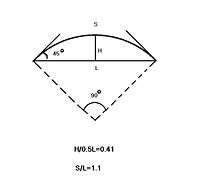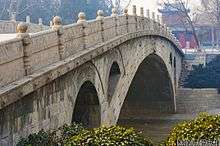Anji Bridge
| Anji Bridge | |
|---|---|
 The Anji Bridge, still standing after 1400 years | |
| Coordinates | 37°43′13″N 114°45′48″E / 37.7203°N 114.7633°ECoordinates: 37°43′13″N 114°45′48″E / 37.7203°N 114.7633°E |
| Crosses | Xiao River |
| Locale | Zhao County in Hebei Province, China |
| Characteristics | |
| Design | Open-spandrel stone segmental arch bridge |
| Total length | 50.82 metres (167 ft) |
| Width | 9.6 metres (31 ft) |
| Height | 7.3 metres (24 ft) |
| Longest span | 37.37 metres (123 ft) |
| History | |
| Construction start | 595 CE |
| Construction end | 605 CE |
The Anji Bridge (simplified Chinese: 安济桥; traditional Chinese: 安濟橋; pinyin: Ānjì Qiáo; literally: "Safe crossing bridge") is the world's oldest open-spandrel segmental arch bridge of stone construction.[1] Credited to the design of a craftsman named Li Chun, the bridge was constructed in the years 595-605[2] during the Sui dynasty (581–618). Located in the southern part of Hebei Province, it is the oldest standing bridge in China.
Name and location
The bridge is also commonly known as the Zhaozhou Bridge (simplified Chinese: 赵州桥; traditional Chinese: 趙州橋; pinyin: Zhàozhōu Qiáo), after Zhao County, which was formerly known as Zhaozhou (趙州). Another name for the bridge is the Great Stone Bridge (simplified Chinese: 大石桥; traditional Chinese: 大石橋; pinyin: Dàshí Qiáo). It crosses the Xiaohe River (洨河) in Zhao County, approximately 40 kilometres (25 mi) southeast of the provincial capital Shijiazhuang. It is a pedestrian bridge and is currently open to the public. In English literature, it is also referred as Chiao Shui Bridge, after the river it crosses. [3] [4]
History
Starting from 581 CE, the Sui dynasty reasserted imperial control over the competing powers that had ruled various regions of China since the decline of the Han dynasty in the third century. Thus immense public works projects were carried out, including the rebuilding of two grand imperial capitals, the excavation of the 2400-kilometer-long Grand Canal, and major improvements to the fortifications that predated the Great Wall. Economically, the long-distance transport of goods and men was a critical component to the interests and sustainability of the ruling house. The movement of goods by land south and southwest from the North China Plain to the Central Plains around Kaifeng and Luoyang followed a path that crossed the Xiao River near Luanzhou (later Zhaozhou and now Zhaoxian) in today's Hebei province. Flowing west to east through a plain that was relatively low-lying on both sides, the Xiao River was an important artery for transporting goods, but an impediment to continuous overland movement and the economic integration of China's regions.[5]
It was under these circumstances that Li Chun, who directed masons and other craftsmen, built the Anji (Safe Passage) Bridge, also called Dashi (Great Stone) Bridge. Although Chinese history credits Li Chun with the design and building of the Anji Bridge, no contemporaneous materials recorded the process, however later chronicles do make notes of it in brief.[5]
Among the most remarkable achievements of Chinese bridge building-indeed an advancement unrivaled in the world-was the creation of this segmental arch bridge of wholly stone construction. This innovation, which occurred between the end of the sixth century and beginning of the seventh century, repudiated conventional wisdom that a semicircular arch was necessary to transfer the weight of a bridge downwards to where the arch tangentially meets the pier. The double pair of openings piercing both ends of the arch spandrel, which as well as accentuating its lithe curvature, lightens the weight of the bridge and facilitates the diversion of flood waters by allowing them to pass through the auxiliary arches rather than pound against the spandrels. The Zhaozhou Bridge is celebrated as China's oldest standing bridge and the oldest open spandrel stone bridge in the world.[5]
Construction

The Anji bridge is about 50 metres (160 ft) long with a central span of 37.37 metres (122.6 ft). It stands 7.3 metres (24 ft) tall and has a width of 9 metres (30 ft). The arch covers a circular segment less than half of a semicircle (84°) and with a radius of 27.27 metres (89.5 ft), has a rise-to-span ratio of approximately 0.197 (7.3 to 37 metres (24 to 121 ft)). This is considerably smaller than the rise-to-span ratio of 0.5 of a semicircular arch bridge and slightly smaller than the rise-to-span ratio of 0.207 of a quarter circle. The arch length to span ratio is 1.1, less than the arch-to-span ratio of 1.57 of a semicircle arch bridge by 43%, thus the saving in material is about 40%, making the bridge lighter in weight. The elevation of the arch is about 45°, which subjects the abutments of the bridge to downward force and sideways force. This bridge was built in 605.
The central arch is made of 28 thin, curved limestone slabs which are joined with iron dovetails. This allows the arch to adjust to shifts in its supports and prevents the bridge from collapsing even when a segment of the arch breaks. The bridge has two small side arches on either side of the main arch. These side arches serve two important functions: first, they reduce the total weight of the bridge by about 15.3% or approximately 700 tons, which is vital because of the low rise-to-span ratio and the large forces on the abutments it creates. Second, when the bridge is submerged during a flood, they allow water to pass through, thereby reducing the forces on the structure of the bridge.
Li Chun's innovative spandrel-arch construction, while economising in materials, was also of considerable aesthetic merit. An inscription left on the bridge by Tang dynasty officials seventy years after its construction reads:
| “ | This stone bridge over the Xiao River is the result of the work of the Sui engineer Li Chun. Its construction is indeed unusual, and no one knows on what principle he made it. But let us observe his marvellous use of stone-work. Its convexity is so smooth, and the wedge-shaped stones fit together so perfectly... How lofty is the flying-arch! How large is the opening, yet without piers!.. Precise indeed are the cross-bondings and joints between the stones, masonry blocks delicately interlocking like mill wheels, or like the walls of wells; a hundred forms (organised into) one. And besides the mortar in the crevices there are slender-waisted iron cramps to bind the stones together. The four small arches inserted, on either side two, break the anger of the roaring floods, and protect the bridge mightily. Such a master-work could never have been achieved if this man had not applied his genius to the building of a work which would last for centuries to come.[6] | ” |
Later history and reputation

During the next 1,400 years, the bridge survived at least eight wars, ten major floods and numerous earthquakes, the most recent being the 7.2-magnitude Xingtai earthquake in 1966. Yet, the support structure remains intact and the bridge is still in use. Only the ornamental railings have been replaced every few hundred years.
The Anji bridge influenced the design of later Chinese bridge structures, such as the similar Yongtong Bridge near Zhaoxian in Hebei. The Yongtong Bridge is a 26 m (85 ft) long stone segmental-arch bridge built in 1130 by the Song structural engineer Pou Qianer.[7][8]
The intriguing design of the Anji bridge has given rise to many legends. According to one legend, the bridge was built by a master architect named Lu Ban in a single night. In another story the bridge was put to the test by two immortals who crossed it at the same time, and Lu Ban saved it by wading into the water and supporting the structure.
Although Ming dynasty (1368–1644) authors compared the bridge to "a new moon rising above the clouds" and "a long rainbow hanging on a mountain waterfall",[6] it later fell into obscurity. When Professor Liang Sicheng of Tsinghua University rediscovered the bridge on a field exploration of ancient architecture in Hebei province, he made detailed measurements and published a report and drawing,[9] after which the bridge became world famous.
Anji bridge was dedicated as an International Historic Civil Engineering Landmark by the American Society of Civil Engineers in 1991. In 1996, the Chinese authorities nominated it for inclusion in the World Heritage List as having "a very important place in the world bridge building history".[10]
See also
- Guyue Bridge, a stone arch bridge completed in 1213, in Zhejiang.
References
- ↑ This title strictly applies only to the sum of attributes given (O’Connor, Colin: Roman Bridges, Cambridge University Press 1993, ISBN 0-521-39326-4, p.171): Various Roman stone pillar bridges featured wooden open-spandrel segmental arches as early as the 2nd century CE, among them Trajan's bridge, the longest bridge of the world to have been built for over a thousand years. Also, a dozen or more Roman close-spandrel stone segmental arch bridges are known from the 1st century BC onwards, such as the Ponte San Lorenzo (Padua), Alconétar Bridge and the Makestos Bridge (Turkey), the last having half-open spandrels. The 27 segmental arches of the Bridge at Limyra (300 ce) feature span to rise ratios between 5.3 and 6.5 to 1, making it an earlier example of a stone quarter circle segmental arch bridge. This leaves the Anji bridge the title of "the oldest open-spandrel stone quarter circle segmental arch bridge in the world".
- ↑ Anji Bridge at Structurae
- ↑ The Golden Age Project
- ↑ Engineering the Ancient World
- 1 2 3 Knapp, Ronald G. (2008). Chinese Bridges: Living Architecture From China's Past. Singapore: Tuttle Publishing. pp. 122–127. ISBN 978-0-8048-3884-9.
- 1 2 Needham, Joseph. The Shorter Science and Civilisation in China. Cambridge University Press, 1994. ISBN 0-521-29286-7. Pages 145-147.
- ↑ Needham, Joseph. (1986). Science and Civilization in China: Volume 4, Physics and Physical Technology, Part 3, Civil Engineering and Nautics. Taipei: Caves Books, Ltd. Page Plate CCCL.
- ↑ http://en.structurae.de/structures/data/index.cfm?id=s0019517 Yongtong Bridge
- ↑ Liang, Ssu-ch'eng (January 1938). "Open Spandrel Bridges of Ancient China. I. The An-chi Ch'iao at Chao-chou, Hopei". Pencil Points: 25–32.
- ↑ Anji Bridge Archived February 21, 2010, at the Wayback Machine., World Heritage Site.
External links
| Wikimedia Commons has media related to Anji Bridge. |
- American Society of Civil Engineers: History and Heritage of Civil Engineering (select "Landmark Projects", then "Zhaoahou Bridge")
- Asian Research
- Chinaculture.org Site sponsored by the Ministry of Culture of the People's Republic of China